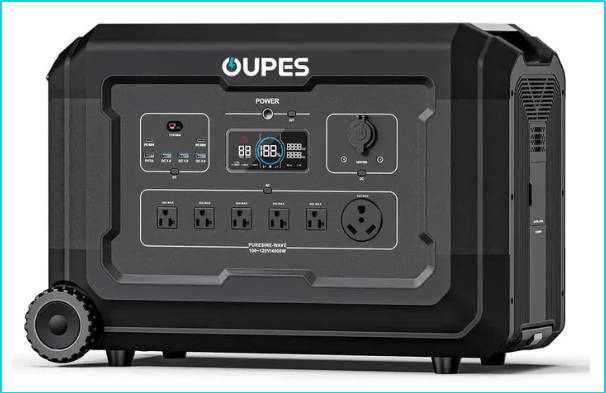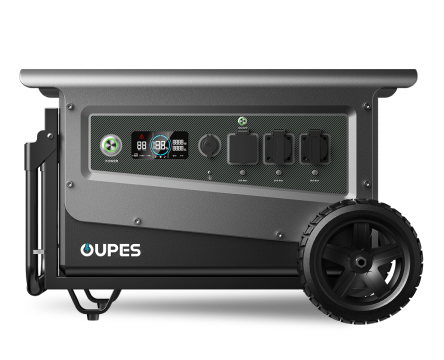
Table of Contents
- Introduction: Why Cold Weather Affects Portable Power Stations
- How Low Temperatures Affect Battery Performance
- Essential Safety Precautions
- Safe Charging Practices in Cold Weather
- Proper Storage and Transportation
- Operating a Portable Power Station Outdoors
- Comparison: Battery Performance in Warm vs. Cold Environments
- How Modern Designs Like OUPES Handle Cold Environments
- FAQ
Introduction: Why Cold Weather Affects Portable Power Stations
Portable power stations are invaluable for outdoor activities, emergency preparedness, and off-grid power. However, when temperatures drop, their performance and safety can be compromised. Understanding how to safely operate, charge, and store these devices in winter conditions ensures reliability and protects the internal battery from long-term damage.
According to the U.S. Department of Energy, cold temperatures can reduce lithium-based battery capacity by up to 30% due to slower chemical reactions inside the cells. With proper precautions, however, your portable power station can continue to perform effectively even in sub-zero conditions.
How Low Temperatures Affect Battery Performance
1. Reduced Chemical Activity
Lithium-ion and lithium iron phosphate (LiFePO₄) batteries rely on ion movement between electrodes. In cold weather (below 0°C / 32°F), this movement slows significantly, reducing available power output and capacity.
2. Voltage Drop and Capacity Loss
You may notice your power station displaying a lower charge or shutting down earlier than expected in cold environments. This is due to temporary voltage depression — a reversible effect that improves once the battery warms up.
3. Slower Charging and Risk of Damage
Charging lithium-based batteries below freezing can cause metallic lithium plating on the anode, which may permanently reduce capacity or pose a safety risk. Therefore, charging should always occur above 0°C (32°F) unless the unit has built-in low-temperature charging protection.
Essential Safety Precautions
To maintain performance and safety during winter, follow these cold-weather precautions for your portable power station or solar generator.
1. Keep the Unit Insulated
Avoid exposing the power station directly to snow or cold winds. Use insulated covers, battery warmers, or store the unit in a tent, vehicle, or enclosed box to keep it above freezing.
2. Avoid Charging Below Freezing
Never charge a lithium-based battery when internal temperature is below 0°C. If needed, warm the unit indoors before recharging.
3. Prevent Moisture Exposure
Condensation can occur when moving between warm and cold environments. Allow the unit to adjust to room temperature before powering on to prevent internal short circuits.
4. Use Cables Rated for Low Temperatures
Cold can make cables brittle. Use flexible, winter-rated cords to prevent cracking or connection failure.
5. Monitor Battery Health
Most modern power stations include battery management systems (BMS) that monitor voltage, temperature, and current. Ensure the display or companion app shows normal readings before operation.
Safe Charging Practices in Cold Weather
1. Warm the Battery Before Charging
Allow the device to reach at least 5°C (41°F) before connecting to a charging source. If outdoors, place it near a mild heat source (never on top of it) or inside an insulated compartment.
2. Use Solar Panels Efficiently
Cold weather often coincides with reduced sunlight. Ensure panels are free from snow and tilted toward the sun to maximize energy intake. Use MPPT (Maximum Power Point Tracking) controllers for efficiency, which many advanced models, such as those by OUPES, include by default.
3. Avoid Rapid Recharging
Fast charging generates heat, which may lead to condensation once temperatures fluctuate. A slow, controlled charge is safer in cold conditions.
4. Keep Charging Ports Dry
Moisture in ports can cause corrosion or short circuits. Always dry connectors and use waterproof port covers when charging outdoors.
Proper Storage and Transportation
1. Store at Optimal Temperature
For long-term storage, keep your portable power station between 10°C and 25°C (50°F–77°F) and at about 50–60% charge. Avoid leaving it in freezing vehicles or unheated garages.
2. Recharge Every Few Months
Cold storage can accelerate self-discharge. Recharge the unit every 3–6 months to maintain internal battery health.
3. Avoid Sudden Temperature Changes
Moving a frozen battery directly into a warm room can cause condensation inside. Let the unit warm up gradually before use.
Operating a Portable Power Station Outdoors
1. Choose the Right Surface
Avoid placing the power station directly on ice or snow. Use an insulated pad, wooden plank, or thermal mat to keep it elevated from cold surfaces.
2. Use in Ventilated Areas
Even though solar and battery-based systems produce no exhaust fumes, keeping proper ventilation prevents overheating during use.
3. Limit High Power Draws
Cold batteries provide lower current output. Avoid running multiple high-wattage appliances simultaneously to prevent voltage drops or auto shutoffs.
4. Keep Display Screens Protected
LCD screens can become sluggish or unresponsive below freezing. Cover the display or operate it through a connected mobile app if available.
Comparison: Battery Performance in Warm vs. Cold Environments
| Condition | Temperature Range | Battery Efficiency | Charging Safety | Typical Capacity Retained |
|---|---|---|---|---|
| Warm Weather (Ideal) | 20–30°C (68–86°F) | 100% | Safe and optimal | 95–100% |
| Cool Weather | 5–15°C (41–59°F) | Good | Safe | 85–95% |
| Cold Weather | 0–5°C (32–41°F) | Moderate | Use caution | 70–85% |
| Freezing or Below | -20–0°C (-4–32°F) | Poor | Unsafe to charge | 50–70% |
As shown, cold temperatures significantly impact both battery efficiency and safe charging thresholds. Using insulation and temperature monitoring can mitigate these effects and prolong the lifespan of your portable power station.
How Modern Designs Like OUPES Handle Cold Environments
Many next-generation portable power stations — including those developed by OUPES — are equipped with intelligent Battery Management Systems (BMS) that automatically regulate charging and discharging temperatures. These systems monitor internal conditions and prevent unsafe charging when the temperature is too low.
Some advanced models feature integrated low-temperature protection or self-heating mechanisms that gently warm the battery before charging begins. This innovation enables reliable performance even in extreme winter conditions, making them suitable for campers, RV users, and emergency preparedness.
FAQ
1. Can I charge my portable power station in freezing temperatures?
No. Charging below 0°C (32°F) can cause lithium plating, permanently damaging the battery. Always warm the device above freezing before recharging.
2. How can I keep my power station warm outdoors?
Use insulated covers or thermal bags, and keep the unit near moderate heat sources such as tents, vehicles, or body warmth — but never directly on heaters.
3. Does cold weather permanently reduce battery capacity?
Not necessarily. Capacity loss during cold weather is usually temporary and will recover once the temperature normalizes. However, repeated deep discharges in the cold can shorten lifespan over time.
4. Can solar panels still work in winter?
Yes. Solar panels generate electricity from light, not heat. However, efficiency may decrease if panels are covered in snow or sunlight is weak. Keep panels clean and properly angled.
5. What’s the ideal storage charge level for winter?
Store the battery at around 50–60% charge and in a location between 10–25°C (50–77°F). Recharge every few months to maintain battery health.
6. How do I know if my power station has low-temperature protection?
Check the product specifications or manual. Many high-end models — including some from OUPES — feature built-in protection systems that automatically disable charging when it’s too cold.




























